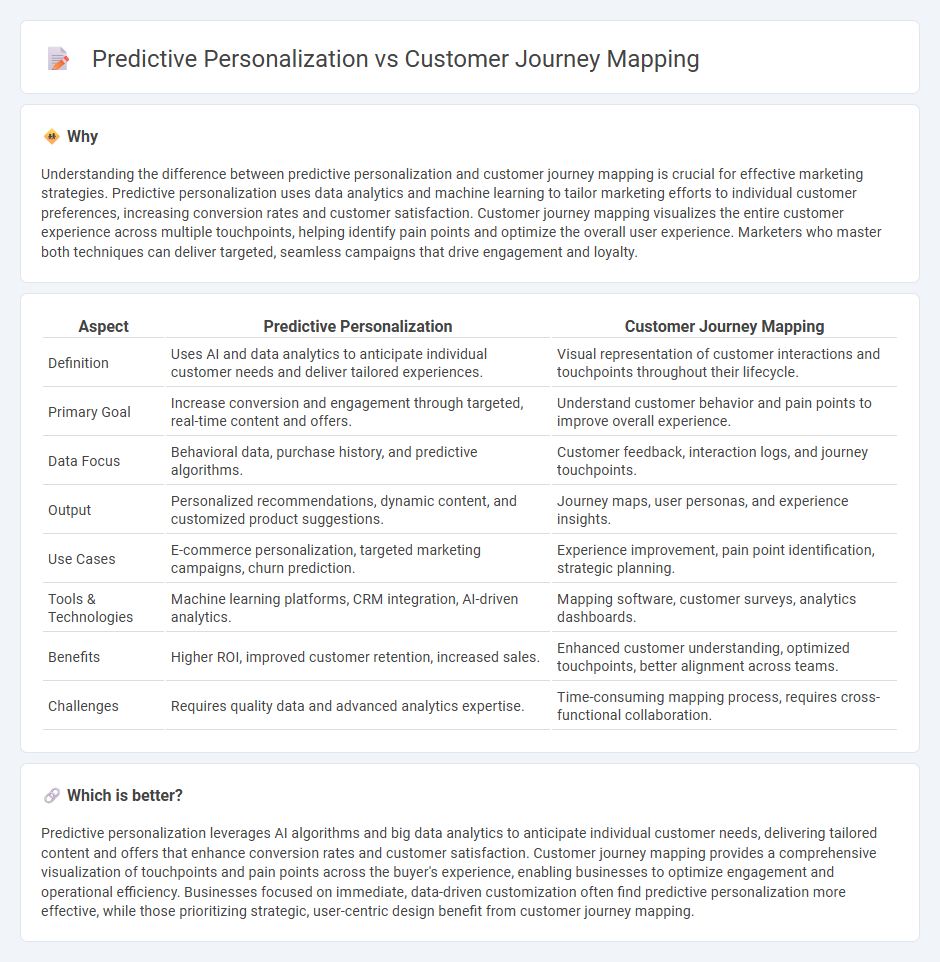
Predictive personalization leverages data analytics and machine learning algorithms to anticipate customer needs and deliver tailored experiences in real-time, significantly enhancing engagement and conversion rates. Customer journey mapping visually outlines the steps and interactions a customer experiences with a brand, providing strategic insights to optimize touchpoints and improve satisfaction. Explore how integrating predictive personalization with customer journey mapping can revolutionize your marketing strategy and drive measurable business growth.
Why it is important
Understanding the difference between predictive personalization and customer journey mapping is crucial for effective marketing strategies. Predictive personalization uses data analytics and machine learning to tailor marketing efforts to individual customer preferences, increasing conversion rates and customer satisfaction. Customer journey mapping visualizes the entire customer experience across multiple touchpoints, helping identify pain points and optimize the overall user experience. Marketers who master both techniques can deliver targeted, seamless campaigns that drive engagement and loyalty.
Comparison Table
| Aspect | Predictive Personalization | Customer Journey Mapping |
|---|---|---|
| Definition | Uses AI and data analytics to anticipate individual customer needs and deliver tailored experiences. | Visual representation of customer interactions and touchpoints throughout their lifecycle. |
| Primary Goal | Increase conversion and engagement through targeted, real-time content and offers. | Understand customer behavior and pain points to improve overall experience. |
| Data Focus | Behavioral data, purchase history, and predictive algorithms. | Customer feedback, interaction logs, and journey touchpoints. |
| Output | Personalized recommendations, dynamic content, and customized product suggestions. | Journey maps, user personas, and experience insights. |
| Use Cases | E-commerce personalization, targeted marketing campaigns, churn prediction. | Experience improvement, pain point identification, strategic planning. |
| Tools & Technologies | Machine learning platforms, CRM integration, AI-driven analytics. | Mapping software, customer surveys, analytics dashboards. |
| Benefits | Higher ROI, improved customer retention, increased sales. | Enhanced customer understanding, optimized touchpoints, better alignment across teams. |
| Challenges | Requires quality data and advanced analytics expertise. | Time-consuming mapping process, requires cross-functional collaboration. |
Which is better?
Predictive personalization leverages AI algorithms and big data analytics to anticipate individual customer needs, delivering tailored content and offers that enhance conversion rates and customer satisfaction. Customer journey mapping provides a comprehensive visualization of touchpoints and pain points across the buyer's experience, enabling businesses to optimize engagement and operational efficiency. Businesses focused on immediate, data-driven customization often find predictive personalization more effective, while those prioritizing strategic, user-centric design benefit from customer journey mapping.
Connection
Predictive personalization leverages data analytics and machine learning to forecast customer behavior, enabling marketers to tailor experiences with precision. Customer journey mapping visualizes each interaction point, providing a comprehensive framework that predictive models use to anticipate needs and optimize touchpoints. Integrating predictive personalization with customer journey mapping enhances targeted marketing strategies, driving higher engagement and conversion rates.
Key Terms
**Customer Journey Mapping:**
Customer Journey Mapping visualizes the entire customer experience by identifying key touchpoints, emotions, and pain points throughout their interaction with a brand, enabling businesses to optimize engagement strategies. It relies on qualitative and quantitative data, such as customer feedback and behavioral analytics, to create detailed personas and scenario-based journeys tailored to specific segments. Explore in-depth how Customer Journey Mapping drives user-centric innovation and boosts customer satisfaction.
Touchpoints
Customer journey mapping identifies and analyzes key touchpoints where customers interact with a brand, providing insights into behavior and preferences at each stage. Predictive personalization leverages data from these touchpoints to anticipate customer needs and tailor experiences in real time, enhancing engagement and conversion rates. Explore how integrating customer journey mapping with predictive personalization can transform your marketing strategy.
Personas
Customer journey mapping visualizes the stages and touchpoints a specific persona experiences with a brand, highlighting pain points and opportunities for engagement. Predictive personalization uses data-driven insights and machine learning to anticipate individual customer needs and tailor interactions dynamically based on persona attributes. Explore how integrating these approaches can enhance targeted marketing strategies and deepen customer connections.
Source and External Links
The customer journey map and why it's important - A customer journey map is a visual representation of the contact points between a customer and a company throughout their relationship, created to understand customer experiences and identify improvement opportunities by setting goals, creating personas, and mapping touchpoints across all stages.
What is a Customer Journey Map? - IBM - It is a detailed visual map capturing every customer experience with a brand, highlighting customer personas, key journey stages, touchpoints, emotions, pain points, and validated through real customer data for accuracy.
30 Best Customer Journey Mapping Tools of 2025 - Customer journey mapping involves tracking all customer interactions from discovery to offboarding using tools and feedback to chart pain points and improve retention; it can be done with various software or simple physical methods depending on business needs.
 dowidth.com
dowidth.com